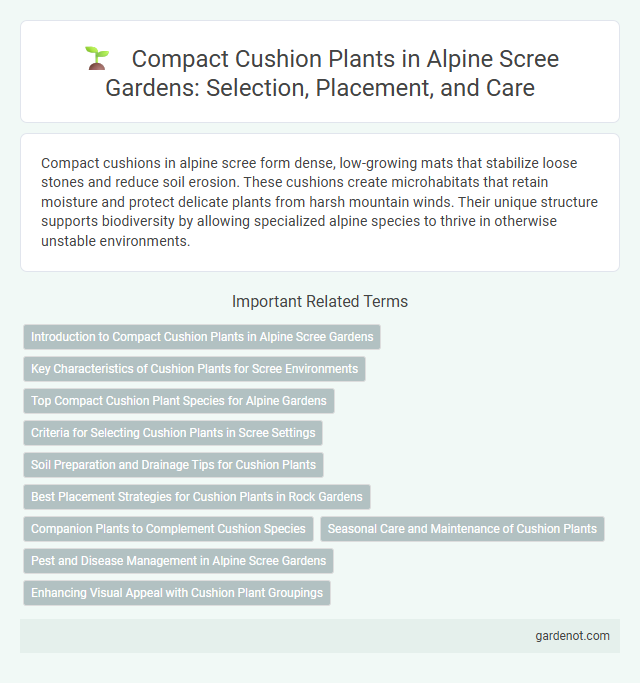Compact cushions in alpine scree form dense, low-growing mats that stabilize loose stones and reduce soil erosion. These cushions create microhabitats that retain moisture and protect delicate plants from harsh mountain winds. Their unique structure supports biodiversity by allowing specialized alpine species to thrive in otherwise unstable environments.
Introduction to Compact Cushion Plants in Alpine Scree Gardens
Compact cushion plants in alpine scree gardens exhibit dense, low-growing formations that reduce exposure to harsh winds and conserve moisture. These hardy species, such as Silene acaulis and Androsace alpina, thrive in nutrient-poor, well-drained rocky substrates typical of high-altitude environments. Their tight, compact growth forms create microhabitats that support biodiversity and stabilize loose scree slopes.
Key Characteristics of Cushion Plants for Scree Environments
Compact cushion plants in alpine scree environments exhibit dense, low-growing mats that minimize exposure to harsh winds and temperature extremes. Their tightly packed foliage reduces moisture loss, enabling survival in nutrient-poor, well-drained scree substrates. These cushions also create microhabitats that stabilize soil and support diverse microbial communities essential for ecosystem resilience.
Top Compact Cushion Plant Species for Alpine Gardens
Top compact cushion plant species for alpine gardens include Silene acaulis, Androsace alpina, and Saxifraga caespitosa, known for their dense, low-growing mats that thrive in rocky, high-elevation environments. These species exhibit exceptional drought resistance and cold tolerance, making them ideal for stabilizing scree slopes and enhancing biodiversity in alpine landscapes. Their compact growth forms reduce wind exposure and conserve soil moisture, contributing to soil retention and ecological resilience in harsh alpine conditions.
Criteria for Selecting Cushion Plants in Scree Settings
Compact cushion plants in alpine scree are selected based on their ability to withstand extreme temperature fluctuations, minimize moisture loss, and resist wind erosion. Key criteria include a dense, low-growing morphology that reduces exposure, deep root systems for anchorage in unstable scree substrates, and physiological adaptations such as hairy or waxy leaf surfaces to retain moisture. These traits ensure resilience and contribute to soil stabilization and ecosystem sustainability in harsh scree environments.
Soil Preparation and Drainage Tips for Cushion Plants
Soil preparation for compact cushion plants in alpine scree requires well-draining, gritty substrates rich in mineral content to mimic their natural habitat. Incorporating coarse sand or fine gravel enhances drainage, preventing root rot in these moisture-sensitive species. Proper drainage ensures the plants remain healthy by avoiding waterlogged conditions common in alpine scree environments.
Best Placement Strategies for Cushion Plants in Rock Gardens
Compact cushion plants thrive in well-drained, sunny rock garden locations where air circulation prevents moisture buildup, reducing rot risk. Position these plants on slight slopes or raised beds with gritty, alkaline soil to mimic their natural alpine scree habitat. Grouping cushions of similar water and light needs promotes healthy growth and enhances visual appeal in the rock garden setting.
Companion Plants to Complement Cushion Species
Compact cushion plants in alpine scree environments thrive alongside companion species such as saxifrages, alpine asters, and sedums, which share similar drought and cold tolerance. These companion plants enhance soil stability, moisture retention, and nutrient cycling within the harsh scree habitat. Their complementary root structures and growth patterns foster microhabitats that support cushion species' resilience against erosion and temperature fluctuations.
Seasonal Care and Maintenance of Cushion Plants
Compact cushion plants in alpine scree require seasonal care that focuses on protecting them from harsh winter conditions and ensuring adequate moisture during dry summer months. Regular removal of accumulated debris and gentle pruning helps maintain their dense structure and promotes healthy growth. Monitoring soil drainage is crucial to prevent root rot, especially during snowmelt periods.
Pest and Disease Management in Alpine Scree Gardens
Compact cushion plants in alpine scree gardens exhibit natural resistance to many pests and diseases, making them low-maintenance choices for harsh environments. Effective pest and disease management includes regular inspection and removal of infected leaves to prevent fungal infections such as powdery mildew. Utilizing well-drained, rocky substrates reduces moisture retention, limiting conditions favorable for pathogens and encouraging healthy plant growth.
Enhancing Visual Appeal with Cushion Plant Groupings
Compact cushion plants in alpine scree create a striking visual appeal through their dense, rounded form and vibrant foliage colors. Grouping these cushion plants intensifies textural contrast against rocky backgrounds, enhancing natural landscape aesthetics. This arrangement promotes biodiversity by providing microhabitats and stabilizing fragile soils in high-altitude environments.
Compact cushion Infographic

 gardenot.com
gardenot.com